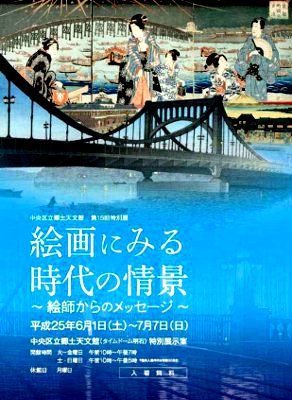The 15th special exhibition "Scenery of the Age in Paintings-Messages from Painters-" has started at Chuo Ward Folk Tenmonkan (Time Dome Akashi). Chuo-ku, the center of Edo and Tokyo, is an exhibition that brings together works from the late Edo period to the end of the war, how paintings have been drawn in paintings. Admission is free for special exhibition, catalogs (A4 size 64 pages booklet) are 200 yen for distribution. The exhibition will be closed on Monday until July 7.
 A total of 76 works (including 5 maps), including 24 works in the Edo period, 36 works in the Meiji period, and 16 works in the Taisho era and Showa eras, are displayed in three periods by age. At the beginning of each period, there is a way to show the map of the time so that the area can be understood.
A total of 76 works (including 5 maps), including 24 works in the Edo period, 36 works in the Meiji period, and 16 works in the Taisho era and Showa eras, are displayed in three periods by age. At the beginning of each period, there is a way to show the map of the time so that the area can be understood.
Looking at the Edo period, most of them are works from the late Edo period from the Tenpo era (1830-1844) to the end of the Edo period. The oldest one is the "Sumida River Ryoshore List West Bank" (Roi Tsuruoka, Edo Tokyo Museum Collection) in 1781 (1781), and the Chuo-ku part is more than 10m from Yanagibashi to Ryogokubashi, Shinohashi, Eitai Bridge, and Tsukuda Island. A picture scroll over 10m. The atmosphere as if you were going down the Sumida River by water bus, such as the scenery seen from Hashimoto, is transmitted.
In the Meiji period exhibition, classic Nishiki-e paintings such as the scenery of Ginza brick streets in Civilization and enlightenment are lined up. The eight prints drawn by Yasuji Inoue, also known as a genius painter who died young, are called "light rays", and capture modern Tokyo in the early Meiji era in a shaded style woven by light.
During the Taisho and Showa eras, he was fascinated by Hasui Kawase's works. The landscape prints drawn with delicate brushwork can be heard in a calm and calm manner. The tail of the Showa period works is "Ginza Reconstruction Emaki" (Yutaka Aso), a live copy of Ginza Street, which stands out from the devastation immediately after the end of the war. @ Akira Makibuchi
◇A related lecture will also be held. For more information, please visit the Local Tenmonkan website. >>Here

 A total of 76 works (including 5 maps), including 24 works in the Edo period, 36 works in the Meiji period, and 16 works in the Taisho era and Showa eras, are displayed in three periods by age. At the beginning of each period, there is a way to show the map of the time so that the area can be understood.
A total of 76 works (including 5 maps), including 24 works in the Edo period, 36 works in the Meiji period, and 16 works in the Taisho era and Showa eras, are displayed in three periods by age. At the beginning of each period, there is a way to show the map of the time so that the area can be understood.
